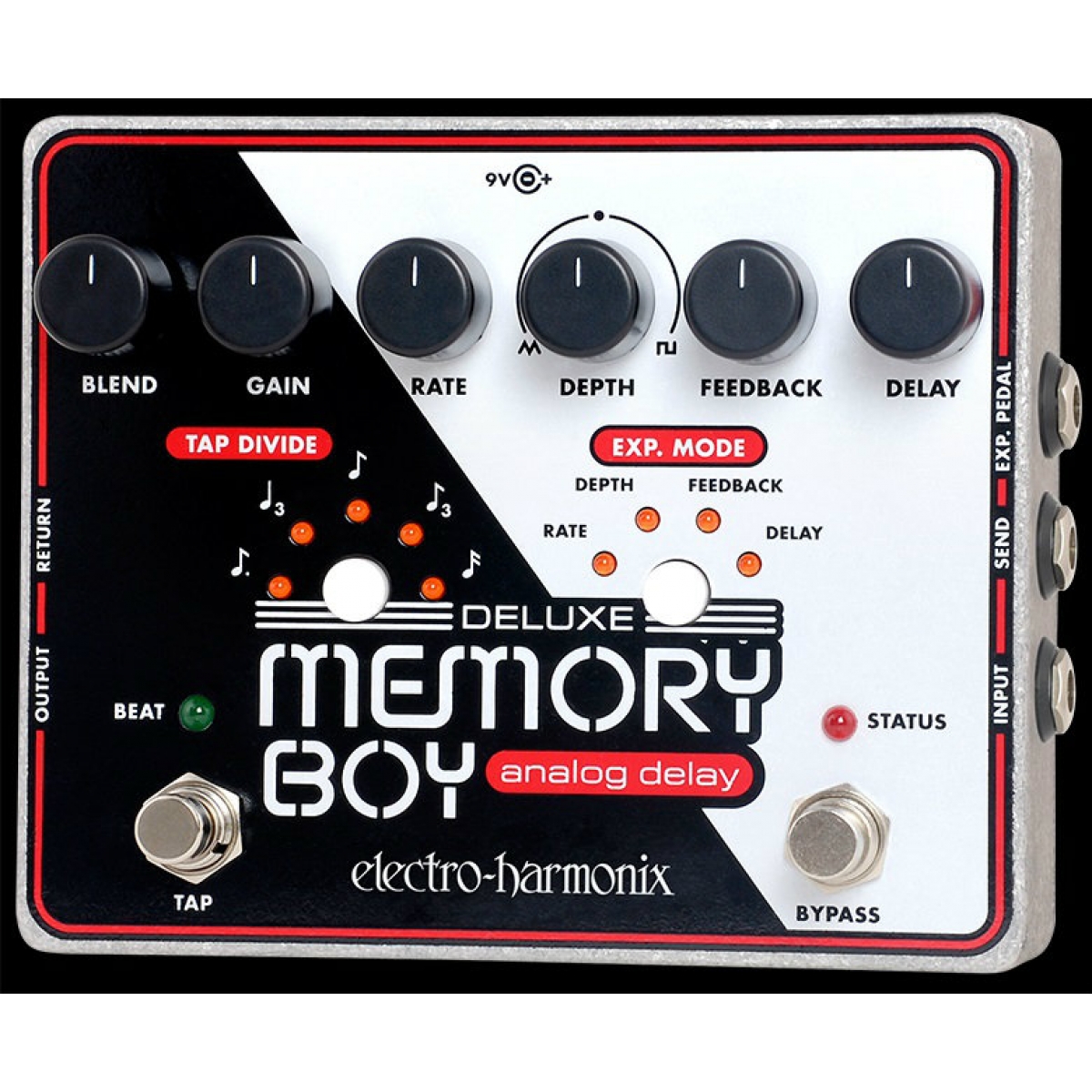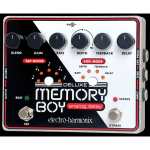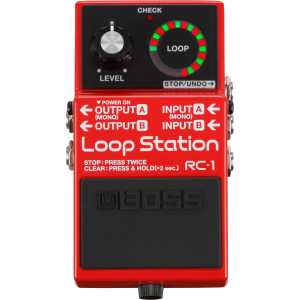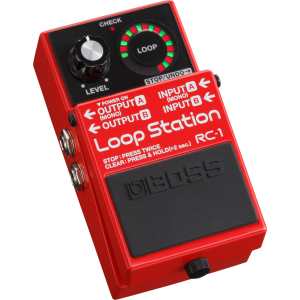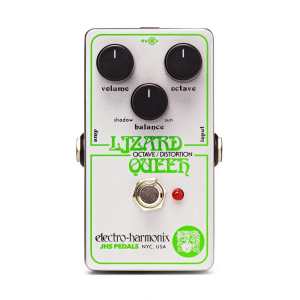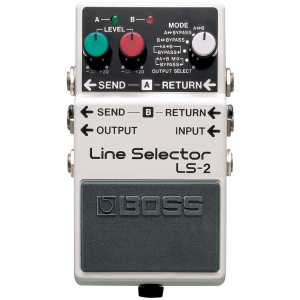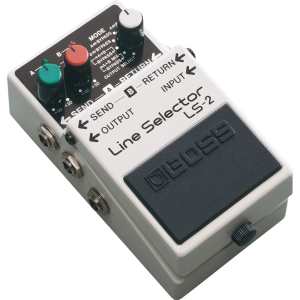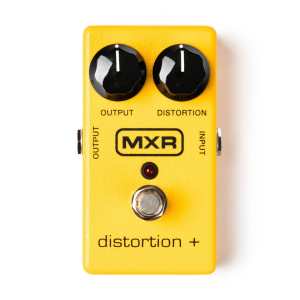Electro-Harmonix Deluxe Memory Boy Analog delay with tap tempo
The Deluxe Memory Boy is the newest delay from the Memory Man family. Quality IC's deliver warm and organic analog tones while "tap tempo" allows you to always be in sync with the groove. Choose five note divisions for metronomic variances. Sweet modulations can be set while the expression pedal input gives you external control. The Deluxe Memory Boy is the most flexible analog delay ever designed.
In the studio or in performance The Deluxe Memory Boy will become a mainstay in your arsenal.
-CONTROLS and INDICATORS –
KNOBS
DELAY Knob — Sets the delay time from 34 mS to 700 mS. As you turn the DELAY knob clockwise, the delay time will increase. If you tap in the delay time, using the TAP Footswitch, the DELAY knob’s setting will be ignored until you move it again. If you turn the DELAY knob after tapping in a delay time, the DELAY knob’s setting will supersede the last tap tempo that was entered. Turning the DELAY knob, while listening to your echoes, will bend the pitch of your notes. The DELAY knob can also be used to set the maximum delay time for expression pedal control. N.B.: the TAP DIVIDE button functions have no effect on the DELAY knob; pressing this button while the DELAY knob controls the delay time will not change the delay time.
FEEDBACK Knob — Controls the amount of signal that is circulated from the output of the delay block to its input. Turning the FEEDBACK knob clockwise increases the number of echoes. Setting the FEEDBACK control to its maximum clockwise position will cause the DXMB to run-away, or self-oscillate. If instead you only want to hear one echo for each of your notes, turn the FEEDBACK knob down to its full counter-clockwise position. The FEEDBACK knob is also used to set the maximum amount of feedback for expression pedal control.
DEPTH Knob — Sets the amount of triangle or square wave modulation that is applied to the delay time. The DEPTH knob has a center detent which signifies the off position for no modulation. Triangle wave modulation occupies the counter-clockwise half of the DEPTH knob, square wave modulation the clockwise half of the DEPTH knob. As you turn DEPTH counter-clockwise from the center-detent’s off position, the amount of TRIANGLE wave modulation increases, to its maximum setting at full counter-clockwise on the DEPTH knob. As you turn the DEPTH knob clockwise from the center-detent position, the amount of square wave modulation applied to the delay time increases, to its maximum setting at full clockwise on the DEPTH knob.
The DEPTH knob is also used to set the maximum amount of modulation for expression pedal control.
RATE Knob — The RATE knob’s main function is to set the rate or speed of modulation. As you turn the RATE knob clockwise the modulation rate will increase. The DEPTH knob must be set to somewhere other than the off position to hear the RATE knob change modulation speed. Additionally the RATE knob sets the maximum rate of modulation for expression pedal control.
The DXMB has a low cut tone control feature which the RATE knob adjusts. Enter low cut mode by pressing and holding down the EXP. MODE button for 2 seconds. After two seconds, all of the EXP. MODE LEDs will light solid and you can release the button. At this point, the RATE knob no longer adjusts the rate of modulation but instead sets the frequency for the DXMB’s low cut filter. As you turn RATE clockwise, less bass will be present in the delayed signal. To completely bypass the low cut filter so that the full bass response comes through, turn the RATE knob down to the full counter-clockwise position. To exit low cut mode, press and release the EXP. MODE button. The DXMB will save the low cut setting, even after power cycling, and it will remain at that setting until adjusted again. The default setting from the factory is for the low cut filter to be bypassed.
GAIN Knob — Sets the input gain for the DXMB. As you turn the GAIN knob clockwise, the input gain will increase. The total gain range is -6 dB to +20 dB. The gain block is the first stage that the input signal goes through in the circuit. Both the dry and wet signals mixed by the BLEND knob go through the gain block.
BLEND Knob — The BLEND knob is a wet/dry control allowing you to vary the mix between direct and delayed signals at the OUTPUT jack of the DXMB. Set the BLEND knob to the full clockwise position for an output that is 100% wet. Set the Blend knob to full counter-clockwise for an output that is 100% dry. Setting BLEND anywhere in between will mix the wet and dry signals together.
SWITCHES & LEDs
BYPASS Footswitch and STATUS LED — The BYPASS FSW is used to toggle the DXMB between effect mode and true bypass mode. The red STATUS LED will light up when in effect mode and turn off in bypass.
TAP Footswitch — The TAP FSW is used to tap in the delay time. Stomp on the TAP FSW two times and the delay time will jump to the time between taps (if all the TAP DIVIDE LEDs are off). If you tap more than twice, it will average the tap tempo for all taps. The DXMB will always take into account the TAP DIVIDE setting when determining the delay time from the tap tempo. For example, if your tap time is 1 second and the TAP DIVIDE setting is eighth notes, the actual delay time is changed to 0.5 seconds. The maximum delay time, when tapped in, is 1.5 seconds; though at this delay time the effect will sound quite lo-fi. The DXMB will save and recall the tap tempo when power cycling.
N.B.: The delay time for the DXMB is always set by the last method used. If you tap in a delay time, the DELAY knob’s setting is ignored. After tapping in a delay time, if you turn the delay knob, the tap time will be forgotten and replaced by the current position of the DELAY knob.
BEAT LED — The green BEAT LED always blinks at a rate that reflects the current delay time, whether you used the TAP FSW or the DELAY knob to set the delay time. The BEAT LED will also reflect the actual delay time rather than your tap time. For example, if your tap time is 900 mS but have the TAPE DIVIDE setting at eighth note triplet, the actual delay time is 300 mS so the BEAT LED will blink every 300 mS. If you are modulating the delay time, the change in delay time due to modulation will also be reflected in the BEAT LED.
TAP DIVIDE Button and LEDs — This button cycles through the six possible settings for TAP DIVIDE. Each setting, except when all LEDS are off, will divide the tap tempo to create shorter delay times in sync with your original tempo. It works like so: The DXMB always assumes that the musician taps in a quarter note. That quarter note can then be divided down to five other types of notes: dotted eighth note, quarter note triplet, eighth note, eighth note triplet and sixteenth note. The sixth mode is quarter note or OFF, where the tap tempo is not divided down and the delay time is set to your actual tap time. No LEDs are lit when Tap Divide is set to quarter note/OFF. Below is a chart displaying the six available modes and how they divide down the tap tempo to produce the actual delay time plus an example delay time setting:
